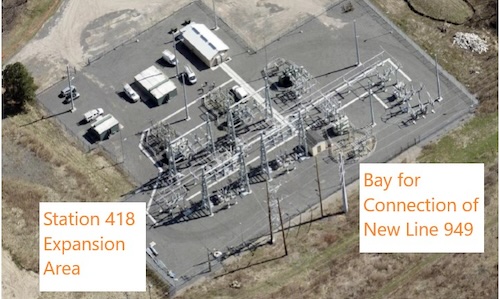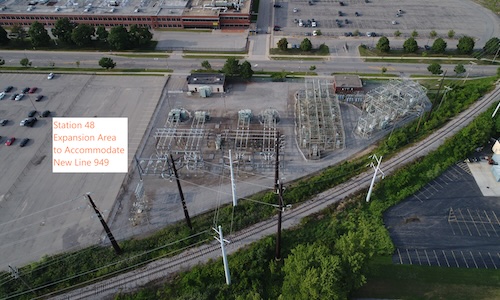1) Survey

Prior to beginning construction activities in any given area, survey crews walk every mile of the route to mark construction locations and right-of-way (ROW) limits in accordance with the approved Environmental Protection and Construction Plan (EM&CP). The survey crews will use different colored flags and stakes to identify clearing limits, danger trees, access roads, structure locations and work spaces, and sensitive natural resources.
2) Clearing

Before construction can begin, vegetation from the ROW must be removed to assist crews in creating a safe, level work surface, and to remove vegetation and trees capable of growing into the transmission lines and "danger trees" that could fall into the lines. After tree removal, the work area will look different, however, native shrubbery and ground cover will typically grow back.
3) Road Work

Existing roads and parking lots will be used where practical. Where necessary, new access roads will be constructed, preferably within the ROW. Timber mats will be used to protect lawns, agricultural fields and other sensitive areas such as wetlands. After construction is complete and the area is completely rehabilitated, we will restore roads and entrances as required. Strict run-off controls will be in place and managed throughout the project.
4) Foundation Work

Structure types and heights are based on the unique engineering requirements for each project location. The structures that will be used for the RTP Enhancement are double circuit monopole structures and will either be direct embed or erected on concrete foundations. For structures with foundations, concrete will be delivered by truck.
5) Structure Placement

Once foundations are in place, construction crews will erect the structures within the ROW. Steel poles will be assembled using a truck-mounted crane and then lifted onto the foundations. Embedded structures will be placed into excavations and which will be backfilled.
6) Wire Work

Insulators and attachment hardware will be installed and stringing sheaves (rollers or blocks) attached to the insulators. The conductors will be strung by attaching the conductor to a steel line and pulled through each structure’s stringing sheaves under tension to keep the conductors well off the ground. Conductor pulling sites located along the ROW will provide space for tractors, trailers with spools of conductor, and tensioning equipment.
7) Restoration

After all construction activities have been completed, ground cover and vegetation are encouraged to grow back. In some areas vegetative buffers or other landscaping may be installed. Good construction practices will be used to stabilize disturbed soils to promote re-vegetation and progress will be monitored. If any damage occurs to roads, they will be restored to their original state.
Station 418

Station 418 construction stages include:
- Mobilize crews and perform preliminary site work on the 115kV yard of the substation
- Site rebuild and creation of Storage Area
- Rebuild of the substation, including the addition of a new bay to accommodate Transmission Line 949
- Put in place line outages to connect existing Transmission Lines 947 and 910, and new Transmission Line 949 to their assigned bays
Station 48

Station 48 construction stages include:
- Under existing conditions: mobilize crews and site preparation
- Site expansion and Transmission Line 949 bay construction
- Perform the work inside the substation for upgrades to the equipment